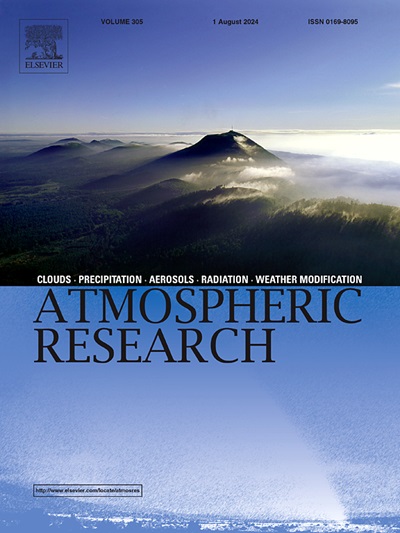西藏西部涡旋的天气观
IF 4.5
2区 地球科学
Q1 METEOROLOGY & ATMOSPHERIC SCIENCES
引用次数: 0
摘要
西藏西部涡旋(WTV)是一个由月资料识别的大尺度大气环流型。它具有准正压结构,中心位于青藏高原西部上空,是青藏高原西部大气环流变率的主导模态。然而,目前对WTV的研究主要集中在年际和季节变化上,缺乏对天气尺度过程的详细研究。我们利用每日的ERA-Interim再分析来评估天气尺度上WTV活动的内在时间尺度和WTV事件的生命周期。研究发现,天气尺度上WTV的时间演变可以解释为一个红噪声(一阶马尔可夫)过程,其电子折叠时间尺度在4.6 ~ 6.9 d之间,春夏季持续时间较长,秋冬季持续时间较短。天气性WTV事件的复合生命周期在发展和高峰阶段表现为横跨欧亚大陆的三中心波列型(斯堪的纳维亚-西西伯利亚-西TP),而在消散阶段则转变为双中心偶极子型(西西伯利亚-西TP)。在发展和高峰阶段,强度变化呈向东传播趋势,三个中心几乎都有东移趋势。相反,在消散阶段,两个中心的强度传播最小,西西伯利亚中心的位置向西移动。我们的结果表明,波的活动性在发展高峰阶段和耗散阶段可能不同。这为进一步研究WTV的动力学特性奠定了基础。本文章由计算机程序翻译,如有差异,请以英文原文为准。
A synoptic view of the Western Tibetan Vortex
The Western Tibetan Vortex (WTV) is a large-scale atmospheric circulation pattern recognized from monthly data. It has a quasi-barotropic structure, with its center located over the western Tibetan Plateau (TP) and provides the leading mode of variability of the western TP atmospheric circulation. However, existing research on the WTV mainly focuses on its interannual and seasonal variability, lacking detailed examination of synoptic scale processes. We utilize the daily ERA-Interim reanalysis to assess the intrinsic timescale of WTV activity, and the lifecycle of WTV events, at the synoptic scale.
We find that the temporal evolution of the WTV at the synoptic scale can be interpreted as a red-noise (First-order Markov) process with an e-folding timescale ranging from 4.6 to 6.9 days, with a relatively longer duration in spring and summer and shorter duration during autumn and winter. The composite lifecycle of synoptic WTV events is characterized by a three-center wave train-like pattern across Eurasia (Scandinavia-West Siberia-western TP) during the developing and peak phases, while transitioning to a two-center dipole pattern (West Siberia-western TP) during the dissipating phase. During the developing and peak phases, intensity changes propagate eastward, accompanied by the eastward movement of nearly all three centers. In contrast, during the dissipating phase, the intensity of the two centers shows minimal propagation, with the West Siberia center shifting westward in position. Our results indicate that wave activity may differ between the developing-peak stages and the dissipation stage. This provides a foundation for further exploration on the dynamical characteristics of the WTV.
求助全文
通过发布文献求助,成功后即可免费获取论文全文。
去求助
来源期刊

Atmospheric Research
地学-气象与大气科学
CiteScore
9.40
自引率
10.90%
发文量
460
审稿时长
47 days
期刊介绍:
The journal publishes scientific papers (research papers, review articles, letters and notes) dealing with the part of the atmosphere where meteorological events occur. Attention is given to all processes extending from the earth surface to the tropopause, but special emphasis continues to be devoted to the physics of clouds, mesoscale meteorology and air pollution, i.e. atmospheric aerosols; microphysical processes; cloud dynamics and thermodynamics; numerical simulation, climatology, climate change and weather modification.
 求助内容:
求助内容: 应助结果提醒方式:
应助结果提醒方式:


